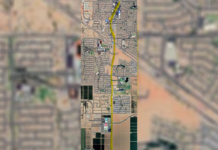
Maricopa City Council approved a balanced $40 million budget for the 2011-12 fiscal year thanks in part to shared health care costs and reductions in travel, conferences, dues and subscriptions.
“When we started going through the budget as a subcommittee, one of the first things we tried to achieve was to have staff come back with a bare-minimum approach to the budget while trying to keep intact some philosophical issues including trying to keep all jobs, not raising taxes and not reducing essential city services,” said Councilmember Carl Diedrich.
“I think we all agreed that those were our last-resort options and we wanted to make the budget work without having to go there," he said. "That being said, everything was on the table and I believe we all kept a very open mind and the tougher cuts would be recommended if necessary.”
City staff and Council discussed the budget during a retreat on May 6. It was an all-day affair in which Council questioned department heads on their expenses and intentions. It was also new City Manager Brenda Fischer’s first week on the job.
“During the interview process Council did a good job of communicating the needs of the city to City Manager Fischer and I think she had a very good sense of our goals,” Diedrich said. “She also brought with her an outsider’s viewpoint that allowed her to make recommendations to the Council on cuts based on a financial or needs analysis.”
“Fischer did a good job at facilitating the directions of the Council,” said Councilmember Alan Marchione. “I didn’t believe some of these memberships and certifications were needed as all they were doing were building peoples’ resumes on taxpayer dollars.”
“We left no stone unturned,” said Councilmember Marvin Brown.
The city expects a surplus of about $100,000, which would make it the first year since 2008-09 it is able to make deposits into its reserve accounts. Although the budget will be in the black, Marchione said the Council will continue looking at operating expenditures of the departments to save more taxpayer money.
Diedrich concurred.
“Under the leadership of a fiscally prudent council and our new city manager, I believe this Council is ready to ask the tough questions and work hard to save,” he said. “We are also ready to support programs that are necessary and aren’t just cutting for the sake of cutting.”
Marchione thought the 80/20 health insurance sharing package was one the best moves for the city.
“I thought it should be a 30 percent share, more representative of what normal contributions are in the private sector, but I felt 20 percent was acceptable,” Marchione said. “There were no layoffs, either. I think that is important to note and we are actually hiring more staff.”
Marchione said moving Assistant City Manager Patrick Melvin back to police chief was good for both the city and the department.
Melvin will be paid according to his reclassification and the city will hire an administrative assistant for the council and an economic development coordinator to work with Danielle Casey, the Department’s director.
“Economic development is doing all it can,” Marchione said. “However, we want to keep investigating economic opportunities so that Maricopa is truly a place where people can work, live and play. We want to be the hub of the wheel, but we need the spokes, the investors, to help make it happen. Believe me, I got a family and I know the costs of going out of town for entertainment.”
Diedrich said because of Maricopa’s size it may be able to attract sports franchises or a theme park.
“I think that with a population of nearly 44,000 we have the capacity to begin engaging companies who can facilitate entertainment expansion in Maricopa,” Diedrich said. “The engagement of sports leagues and franchises is not something we should shrug our shoulders at.
“I believe City Council should also be looking at theme park possibilities.
"Phoenix is the only large metropolitan area in the United States without a branded theme park. Most often those parks sit at the exterior ring of the suburban areas of a city, and Maricopa is very much like the Anaheim of the ’50s and the Orlando of the ’60s and ’70s.”
Citing examples of how Council is working to bring in new investment, Marchione pointed to the Banner Health Center and Central Arizona College agreements.
“These places will create real jobs, and I will always support that kind of growth,” Marchione said.
In addition to its $40-million operating budget, the city has earmarked another $50 million for capital projects such as a new city hall and aquatics complex.


![Carl’s Jr plans to “open soon” An exterior view of the new Carl's Jr. restaurant along John Wayne Parkway on May 7, 2024. [Elias Weiss]](https://www.inmaricopa.com/wp-content/uploads/2024/05/E1C66482-CB4C-4FD0-BA30-35CECE93F4BE-218x150.jpeg)
![Filiberto’s eyes building Maricopa restaurant An exterior view of a Filiberto's Mexican Food restaurant at an unknown location and date. [Jessica Boehm/Axios]](https://www.inmaricopa.com/wp-content/uploads/2024/05/axios-050724-filibertos-screenshot-e1715117410101-218x150.jpg)
![SR 238 closures start tomorrow SR 238 [File]](https://www.inmaricopa.com/wp-content/uploads/2022/04/az-238_e_seq_034-218x150.jpg)




![In mayoral race, it’s the Nancy Smith show Maricopa Chamber of Commerce Executive Director Kelly Anderson grills incumbent Mayor Nancy Smith in election's first campaign event April 30, 2024, at Southern Dunes Golf Club. [Elias Weiss]](https://www.inmaricopa.com/wp-content/uploads/2024/04/CRM_1009-218x150.jpg)





![Carl’s Jr plans to “open soon” An exterior view of the new Carl's Jr. restaurant along John Wayne Parkway on May 7, 2024. [Elias Weiss]](https://www.inmaricopa.com/wp-content/uploads/2024/05/E1C66482-CB4C-4FD0-BA30-35CECE93F4BE-100x70.jpeg)
